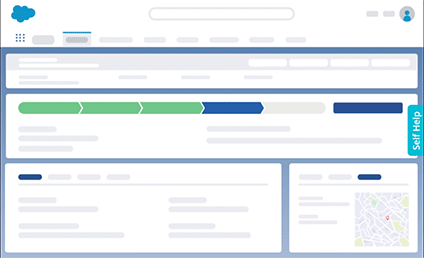
Priyanka Malik


Setting clear and effective training objectives is the cornerstone of any successful learning and development strategy.
From corporate training, end-user education, or employee development areas, well-defined training objectives provide a roadmap for both trainers and learners, ensuring that efforts are directed towards specific, measurable, and achievable goals.
In this article, we explore the role of training objectives, how they guide the learning process and contribute to increased motivation, focused outcomes, and ultimately, improved performance.
By understanding the principles behind crafting meaningful training objectives, you can unlock the full potential of training programs and create learning experiences that drive real outcomes.
Training objectives are the predetermined and measurable outcomes that your employees are expected to achieve after completing a training program. These objectives must clearly communicate the tangible benefits of the training program in a way that engages and resonates with employees. A well-defined training objective consists of three main components: performance, condition, and criteria.
Here are three types of employee training objectives.
Knowledge-based training objectives focus on imparting specific information, facts, concepts, or theories to employees. These objectives are designed to enhance participants’ understanding and awareness of a particular subject matter.
The aim is to ensure that employees have a solid foundation of knowledge that’s essential for their roles. Knowledge-based training often involves presentations, lectures, reading materials, and informational videos.
For example, a knowledge-based objective for customer service representatives might involve training them on the company’s product specifications, industry terminology, or regulatory guidelines. The goal is to equip employees with the necessary background information to perform their tasks effectively.
Skill-based training objectives center around developing practical abilities, techniques, and competencies. The focus here is on enhancing an employee’s capability to perform specific tasks or activities required for their job. Skill-based training often includes hands-on exercises, simulations, role-playing, and practice sessions.
For instance, a skill-based objective for software developers could involve training them in a new programming language, debugging techniques, or software architecture design. By targeting skill development, organizations ensure that employees can execute their responsibilities with proficiency, leading to improved job performance.
Attitude-based training objectives revolve around shaping employees’ attitudes, beliefs, and behaviors towards certain aspects of their work. These objectives are aimed at influencing employees’ perceptions and fostering a positive mindset conducive to a productive and harmonious work environment.
Attitude-based training involves activities such as group discussions, case studies, and workshops that encourage self-awareness, empathy, and teamwork.
For instance, an attitude-based objective for leadership training could focus on cultivating effective communication skills, conflict resolution, or adaptability. By addressing attitudes and behaviors, organizations create a workplace culture that supports collaboration, creativity, and employee satisfaction.

Here are six tips for you to create clear employee training objectives that make an impact.
Before crafting training objectives, it’s crucial to have a clear understanding of why the training is being conducted and what specific outcomes are desired. The objectives should articulate what participants are expected to achieve by the end of the training.
Defining the purpose and desired outcomes ensures that the training objectives are relevant and aligned with the overarching goals of the program.
Conduct a thorough training need analysis to identify skill gaps, areas for improvement, and the specific knowledge or competencies that need to be addressed. This analysis helps tailor the training objectives to meet the actual requirements of the learners and the organization.
It ensures that the training is focused on addressing the most critical needs and is not redundant or irrelevant.
Training objectives should be concise and easy to understand. Avoid excessive jargon or complex language. Aim for clarity and brevity to ensure that participants can quickly grasp the intended outcomes of the training. Clear and straightforward objectives are more likely to resonate with learners and help them stay focused on their learning goals.
Utilize the SMART framework when creating training objectives. SMART stands for Specific, Measurable, Achievable, Relevant, and Time-bound.
Each objective should be specific in terms of what will be achieved, measurable so progress can be tracked, achievable within the resources available, relevant to the learners’ needs, and set with a clear timeframe for completion. SMART goals provide a structured and well-defined framework for effective training design.
✓ Thank you, the template will be sent to your email
Bloom’s Taxonomy categorizes learning objectives into different cognitive levels, ranging from simple knowledge recall to higher-order thinking skills like analysis and synthesis. When creating training objectives, consider the level of cognitive engagement you want participants to achieve.
This helps in designing appropriate activities and assessments that align with the intended learning outcomes.
Training objectives should align with the broader strategic goals of the organization. Ensure that the skills and knowledge being targeted in the training contribute to improving job performance and, ultimately, the achievement of organizational objectives. This alignment ensures that training efforts have a tangible impact on the company’s success.


In addition to completing company-specific goals, your training goals are beneficial for the following reasons:
Clear and well-defined training objectives provide employees with a roadmap of what they need to learn and achieve during the training program. When employees know exactly what is expected of them, they can focus their efforts on acquiring the necessary skills or knowledge.
Clarity in objectives reduces confusion and uncertainty, helping employees understand the purpose and relevance of the training to their roles. This, in turn, leads to more effective learning and a sense of direction in their development journey.
Clear objectives create a sense of accomplishment as employees make progress toward their targets, fostering a positive learning experience. Additionally, when employees see that their development is aligned with their career growth and the organization’s goals, they are more motivated to actively participate and excel in the training program.
Training objectives directly contribute to improved performance and productivity. By aligning training material with the skills and knowledge required for specific job tasks, employees can acquire the tools they need to perform more effectively.
As employees become proficient in their roles, they can complete tasks more efficiently, make fewer errors, and contribute positively to overall organizational productivity. Well-defined objectives ensure that training efforts are tailored to address skill gaps and areas for improvement, resulting in enhanced job performance.
Setting clear training objectives makes it easier to measure the return on investment (ROI) of training initiatives. When objectives are specific and measurable, it becomes straightforward to assess whether the training program has achieved its intended outcomes.
By comparing the before-and-after performance of employees in relation to the established objectives, organizations can determine the effectiveness of the training in terms of skill improvement, knowledge gain, and behavior change. This data-driven analysis helps organizations make informed decisions about the value of their training investments.
Creating training objectives guides the design of training materials and content. Objectives serve as the foundation upon which the curriculum, exercises, assessments, and learning resources are built.
They help trainers and instructional designers focus on relevant and essential content, ensuring that the training is both comprehensive and targeted. Training materials aligned with objectives ensure that the learning experience is cohesive, logical, and directly applicable to the desired outcomes.
Here are a few employee training challenges that L&D managers might encounter while setting training objectives.
One of the significant L&D challenges in setting and achieving training objectives is the establishment of unrealistic goals. When objectives are overly ambitious or not grounded in the reality of the employees’ current skill levels and available resources, it can lead to frustration and demotivation.
Employees might perceive these goals as unattainable, leading to a lack of commitment to the training process. To overcome this challenge, organizations must ensure that training objectives are achievable, yet challenging enough to encourage growth.
Regular assessments of progress can help determine if adjustments are needed to keep objectives within a realistic scope.
Aligning training objectives with both individual employee needs and broader organizational goals can be a complex task. When objectives are not closely tied to employees’ roles or do not contribute to the organization’s strategic priorities, employees may question the relevance of the training.
Lack of alignment can result in disengagement and decreased commitment to the training program. It’s important to ensure that training objectives are designed to address specific skill gaps relevant to employees’ job functions and that they contribute to the organization’s overall success.
Resource constraints, whether financial, technological, or human, can hinder the achievement of training objectives. Inadequate resources can impact the development of training materials, the availability of trainers, and the provision of necessary tools and technologies.
This challenge can compromise the quality and effectiveness of the training experience. Organizations need to allocate sufficient resources to support the training process, including budget for materials, time for both trainers and learners, and access to the technology required for effective training delivery.
Resistance to change is a common obstacle when introducing new training initiatives and objectives. Employees might be resistant to adopting new skills, technologies, or processes, particularly if they perceive these changes as disruptive or outside their comfort zones.
Overcoming resistance requires effective change management strategies, transparent communication about the benefits of the training, and creating a supportive environment where employees feel safe to explore and adapt to new ways of working. Addressing concerns and emphasizing the positive outcomes of training can help mitigate resistance.
This challenge can compromise the quality and effectiveness of the training experience. Organizations need to allocate sufficient resources to support the training process, including budget for materials, time for both trainers and learners, and access to the technology required for effective training delivery.

Setting training objectives only matters if you’re also tracking progress toward those objectives. So how do you measure the success of training objectives?
Here are three ways to track progress towards training objectives:
Pre- and post-training assessments involve evaluating employees’ knowledge, skills, or competencies before and after the training program. By comparing the results of these assessments, organizations can measure training effectiveness in terms of learning outcomes.
Pre-training assessments establish a baseline, highlighting the areas where employees need improvement. Post-training assessments then reveal the extent of knowledge or skill enhancement achieved as a result of the training.
The difference between pre- and post-training scores provides a quantitative measure of the training’s impact on participants’ abilities. This method allows for objective measurement of progress and can identify specific areas where the training has been successful or needs further refinement.
The ultimate goal of training is to enhance employees’ job performance. The success of training objectives can be measured by observing and evaluating how effectively employees apply the acquired knowledge and skills in their day-to-day tasks.
Supervisors, managers, or trainers can assess employees’ performance on job-related activities to determine whether the training has translated into practical and tangible improvements. This approach provides real-world evidence of the training’s impact and its contribution to better performance.
Collecting feedback from participants through surveys, interviews, or focus groups is a valuable qualitative method for measuring training success. Participants’ perception on training relevance, content, delivery, and impact can provide insights into their overall satisfaction and the perceived effectiveness of the training.
Feedback helps reveal whether participants believe the training met their expectations, whether they feel more confident in their abilities, and whether they see the training as valuable to their roles. Analyzing feedback allows organizations to identify strengths and areas for improvement in the training program, making adjustments for future iterations.
Investing in a Digital Adoption Platform (DAP) offers a transformative solution for achieving and measuring training objectives by providing real-time guidance, personalized learning experiences, and comprehensive analytics. A DAP streamlines the learning process, offering contextual, on-screen guidance that aids users in navigating software and applications seamlessly, effectively bridging the gap between training and practical application. This accelerates skill acquisition, ensuring that employees swiftly achieve training objectives.
Additionally, DAPs such as Whatfix offer sophisticated analytics that track user interactions, identifying areas of proficiency and pain points, thus enabling precise measurement of skill improvement and learning retention. Through targeted assessments and usage data, organizations can quantitatively evaluate training effectiveness and tailor ongoing learning initiatives, ensuring a continuous cycle of improvement aligned with the set objectives.
Thank you for subscribing!